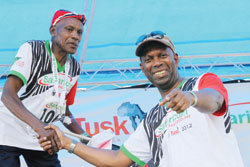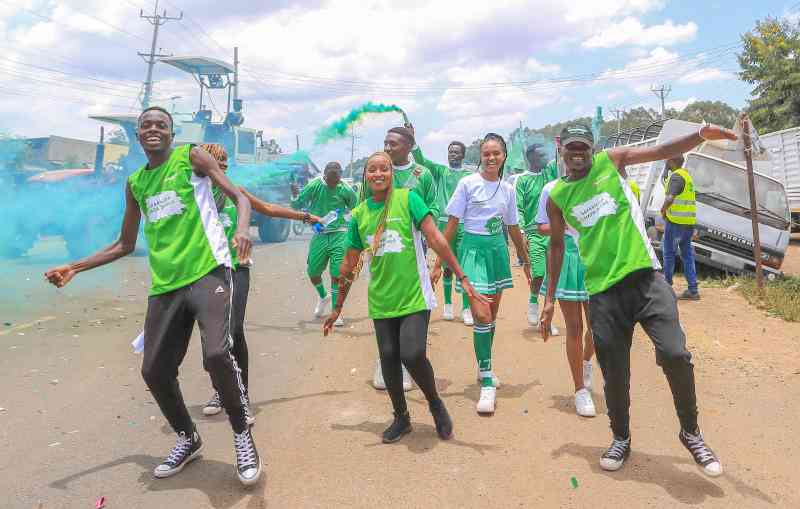 |
|
An elderly but seasoned marathoner aged 82, is congratulated by Safaricom CEO Bob Collymore after finishing the 21 km race. |
It is rugged, fun and breath-taking. As one of the extraordinary endurance marathons in the world, the Safaricom Lewa Marathon continues to challenge long distance runners and thrill athletic fans and spectators, writes ALLAN OLINGO
From walkers to fun runners, amateurs, world-renowned professionals, jokers and spectators, runners of all abilities take part in Safaricom Lewa Marathon, one of the most anticipated sporting and social events held within a wildlife conservancy.
We left for the Lewa Conservancy on a cold Friday morning and it was encouraging to see participants full of great expectations as they waited to run side by side with the wild animals.
Located in northern Kenya, the Lewa Conservancy which is about four hours drive and a 45-minute flight from Nairobi is home to the almost extinct gravy zebra and black rhinos, which are now under a 24 hour security surveillance.
Five hours later, we arrived at the main gate and underwent a thorough security check before we drove into the conservancy. On the way we were met by a huge herd of giraffes and zebras that seemed comfortable with us driving right by them.
By the time we reached our residence, the Safaricom village, everyone was excited. The race the next day was going to be interesting!
I had never attempted the Lewa Marathon as a runner. It needs a good mental shape to participate leave alone win!
BRAVE SOULS
This marathon is not for jokers, especially if you are determined to finish it. It requires good preparation. My contribution to the marathon was to cheer the teams and individuals who participated in the actual event, from the sidelines. Such brave souls!
Morning came and the sound of the choppers flushed me out of my tent. Because the Lewa Conservancy is on the leeward side of Mount Kenya, the cold was at another level. My colleagues and I unanimously opted to suspend any ‘showering’ activity till a favourable time. It never came, at Lewa. Well, that’s a story for another day.
The race kicked of at 7am and it did not fail to thrill. The race had garnered fans and supporters from across the globe. Running on rough terrain and under harsh climatic conditions, the Lewa Marathon has gained a reputation as one of the ten toughest marathon events in the world.
THE COURSE
Most of the runners were drawn into the 21-kilometre category. The only difference they had with the full marathon runners was that they were not keen on the time but just finishing the race.
To enhance the safety of the event, the running course is manned by a large and experienced team of game rangers, with two helicopters and a fixed wing spotter plane, giving the aerial surveillance to ensure the safety of runners throughout the race. There were also water stations and first aid points situated every 2.5km, with medical support provided by AMREF and the Red Cross.
World acclaim
Stay informed. Subscribe to our newsletter
The Safaricom Lewa marathon draws distance runners and athletic fans from all over the world, with big groups of runners coming from the United States and United Kingdom, as well as runners from Australia, France, Germany, India, Europe, the Far East and Canada. Many of them jet into the country to specifically have fun in the wild. Sports tourism it is.
Over 1,000 runners took part in the full and half-marathon with an additional 100 children competing in the 5km fun run.
The marathon is run on dirt roads, over two 21km loops (one for the half-marathon, two for those running the full marathon). With Mount Kenya to the south and Samburu and Mount Lololokwe to the north, this backdrop adds to the whole Lewa experience. Its picturesque setting, which encompasses some of the world’s most beautiful scenery, that makes the marathon all the more worthwhile.
As the race came to an end, I was really impressed by an 82-year-old Kenyan runner who completed the race, way ahead of many people.
Combat gear
Another major attraction was the soldiers from the British army who were taking part in the race. Clad in the combat gear with almost five kilogrammes automatic rifles in the hands and a backpack that I learnt weighed 20 kilogrammes, they did a walking race covering the 21 kilometres. Now that’s greatness!
The race, which is organised by Tusk Trust and Lewa Wildlife Conservancy in conjunction with Safaricom, is in support of conservation and community projects in the Lewa and Il Ngwesi area, in North Central Kenya.
The Lewa Wildlife Conservancy is a protected 55,000 acre wildlife sanctuary and is home to over 80 rhino, herds of elephant and a vast assortment of game, including the eland, zebra, lions giraffe and buffalos amongst other game.
Noble course
The main purpose of the initiative is to raise funds for wildlife conservation and community projects in Kenya. This joint community partnership between the Il Ngwesi community tourism project and private ranch owners has created a sanctuary for wildlife.
The project breeds endangered rhinos and provides a safe haven and habitat for species threatened by growing human populations in surrounding areas.
The Lewa conservancy protects six per cent of the country’s population of endangered Black Rhino, and 20 per cent of the world’s population of rare Grevy’s Zebra.
The Lewa marathon entrants facilitate the conservation effort by fundraising and seeking sponsorship for their participation, with the funds going directly to the conservation projects, community development, education and healthcare in northern Kenya.
Since its inception in 2000, the Lewa Marathon has raised over Sh243 million that has gone into a range of education, community development, health and wildlife conservation projects across Kenya.
At the end of the race, it was good run in the wild, where runners tested their limits, got their hearts pumping, and experienced the beauty of nature, all for a good cause.
 The Standard Group Plc is a
multi-media organization with investments in media platforms spanning newspaper
print operations, television, radio broadcasting, digital and online services. The
Standard Group is recognized as a leading multi-media house in Kenya with a key
influence in matters of national and international interest.
The Standard Group Plc is a
multi-media organization with investments in media platforms spanning newspaper
print operations, television, radio broadcasting, digital and online services. The
Standard Group is recognized as a leading multi-media house in Kenya with a key
influence in matters of national and international interest.
 The Standard Group Plc is a
multi-media organization with investments in media platforms spanning newspaper
print operations, television, radio broadcasting, digital and online services. The
Standard Group is recognized as a leading multi-media house in Kenya with a key
influence in matters of national and international interest.
The Standard Group Plc is a
multi-media organization with investments in media platforms spanning newspaper
print operations, television, radio broadcasting, digital and online services. The
Standard Group is recognized as a leading multi-media house in Kenya with a key
influence in matters of national and international interest.










